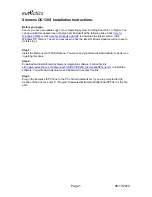
25
of
the
other
groups
should
not
be
used
unless
there
is
a
specific
reason.
These
usually
include
“EEPC52
OPTION:”
or
similar
at
the
start
of
the
name
(example
from
EEPC
v5.2.2).
Some
of
the
optional
compatibility
file
groups
that
should
not
be
assigned
to
machines
unless
a
specific
issue
is
being
addressed:
•
“EEPC52
OPTION:
Exclude
Sector
59
for
NEC
Compatibility”
•
“EEPC52
OPTION:
Tests
for
Computrace
presence”
•
“EEPC52
OPTION:
Update
MBR
for
Endpoint
Encryption
for
PC
compatibility”
•
“EEPC52
OPTION:
Update
number
of
sides
reported
in
the
OS
boot
sector”
•
“EEPC52
OPTION:
WACOM
Active
Tablet
Pen
Driver”
Things
to
avoid
Alternative
supported
method
follows
each
item.
•
Do
not
assign
multiple
Theme
file
groups
Assign
the
Theme
you
require.
•
Avoid
using
SafeTech
via
bootable
USB
stick.
Although
the
function
it
is
available,
the
BIOS
on
many
laptops
causes
the
USB
stick
(at
boot
‐
up)
to
appear
as
a
fixed
drive
and
therefore
swaps
with
the
fixed
disk
after
booting
from
it.
It
can
cause
recovery
problems
with
Remove
or
Emergency
Boot,
for
example.
Alternatively,
use
with
a
floppy
disk
drive
or
bootable
CD
(make
an
ISO
from
the
floppy
disk
to
make
a
bootable
CD).
•
Avoid
making
multiple
fundamental
changes
to
clients
at
once
.
For
example,
changing
the
encryption
state
and
upgrading
EEPC
clients
at
the
same
time
will
cause
problems.
Do
one
major
thing
at
a
time,
allow
clients
to
sync
and
perform
the
change,
then
make
the
second
change.
•
Do
not
assign
multiple
unnecessary
file
groups
as
a
“catch
all
”
for
all
possible
hardware/software
combinations.
Instead,
try
to
group
machines
carefully
and
assign
only
the
necessary
file
groups
for
their
specific
requirements.
•
Do
not
use
the
file
group
“EEPC52
OPTION:
Update
MBR
for
Endpoint
Encryption
for
PC
compatibility”
together
with
“EEPC52
OPTION:
Update
number
of
sides
reported
in
the
OS
boot
sector”
–
they
are
not
compatible
;
Instead,
use
one
or
the
other,
but
only
if
specifically
needed
or
recommended
by
McAfee
Support.


































